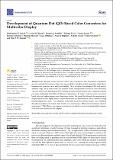Files in this item
Development of Quantum Dots (QD) based color converters for multicolor display
Item metadata
| dc.contributor.author | Sajjad, Muhammad Tariq | |
| dc.contributor.author | Bansal, Ashu Kumar | |
| dc.contributor.author | Antolini, F | |
| dc.contributor.author | Preis, E | |
| dc.contributor.author | Stroea, L | |
| dc.contributor.author | Toffanin, S | |
| dc.contributor.author | Muccini, Michele | |
| dc.contributor.author | Ortolani, L | |
| dc.contributor.author | Migliori, A | |
| dc.contributor.author | Allard, S | |
| dc.contributor.author | Scherf, U | |
| dc.contributor.author | Samuel, Ifor David William | |
| dc.date.accessioned | 2021-04-23T08:30:02Z | |
| dc.date.available | 2021-04-23T08:30:02Z | |
| dc.date.issued | 2021-04-23 | |
| dc.identifier | 273926661 | |
| dc.identifier | d44194f2-11df-421c-9d02-d4ec4da5ceee | |
| dc.identifier | 85104509078 | |
| dc.identifier | 000657014300001 | |
| dc.identifier.citation | Sajjad , M T , Bansal , A K , Antolini , F , Preis , E , Stroea , L , Toffanin , S , Muccini , M , Ortolani , L , Migliori , A , Allard , S , Scherf , U & Samuel , I D W 2021 , ' Development of Quantum Dots (QD) based color converters for multicolor display ' , Nanomaterials , vol. 11 , no. 5 , 1089 . https://doi.org/10.3390/nano11051089 | en |
| dc.identifier.issn | 2079-4991 | |
| dc.identifier.other | Bibtex: nano11051089 | |
| dc.identifier.uri | https://hdl.handle.net/10023/23085 | |
| dc.description | Funding: This research was funded by European commission under FP7 LAMP project “Laser Induced Synthesis of Polymeric Nanocomposite Materials and Development of Micro-patterned Hybrid Light Emitting Diodes (LED) and Transistors (LET)” (Grant No. 247928) | en |
| dc.description.abstract | Many displays involve the use of color conversion layers. QDs are attractive candidates as color converters because of their easy processability, tuneable optical properties, high photoluminescence quantum yield, and good stability. Here, we show that emissive QDs with narrow emission range can be made in-situ in a polymer matrix, with properties useful for color conversion. This was achieved by blending the blue-emitting pyridine based polymer with a cadmium selenide precursor and baking their films at different temperatures. To achieve efficient color conversion, blend ratio and baking temperature/time were varied. We found that thermal decomposition of the precursor leads to highly emissive QDs whose final size and emission can be controlled using baking temperature/time. The formation of the QDs inside the polymer matrix was confirmed through morphological studies using atomic force microscopy (AFM) and transmission electron microscopy (TEM). Hence, our approach provides a cost-effective route to making highly emissive color converters for multi-color displays. | |
| dc.format.extent | 10 | |
| dc.format.extent | 1880255 | |
| dc.language.iso | eng | |
| dc.relation.ispartof | Nanomaterials | en |
| dc.subject | Nanocomposite | en |
| dc.subject | Energy transfer | en |
| dc.subject | Narrow emission | en |
| dc.subject | Thermal annealing | en |
| dc.subject | Nanocrystal | en |
| dc.subject | QC Physics | en |
| dc.subject | TK Electrical engineering. Electronics Nuclear engineering | en |
| dc.subject | DAS | en |
| dc.subject.lcc | QC | en |
| dc.subject.lcc | TK | en |
| dc.title | Development of Quantum Dots (QD) based color converters for multicolor display | en |
| dc.type | Journal article | en |
| dc.contributor.sponsor | European Commission | en |
| dc.contributor.institution | University of St Andrews. Centre for Biophotonics | en |
| dc.contributor.institution | University of St Andrews. Condensed Matter Physics | en |
| dc.contributor.institution | University of St Andrews. School of Physics and Astronomy | en |
| dc.identifier.doi | 10.3390/nano11051089 | |
| dc.description.status | Peer reviewed | en |
| dc.identifier.url | https://www.mdpi.com/journal/nanomaterials/special_issues/Nanocrystals_Synthesis | en |
| dc.identifier.grantnumber | 247928 | en |
This item appears in the following Collection(s)
Items in the St Andrews Research Repository are protected by copyright, with all rights reserved, unless otherwise indicated.

